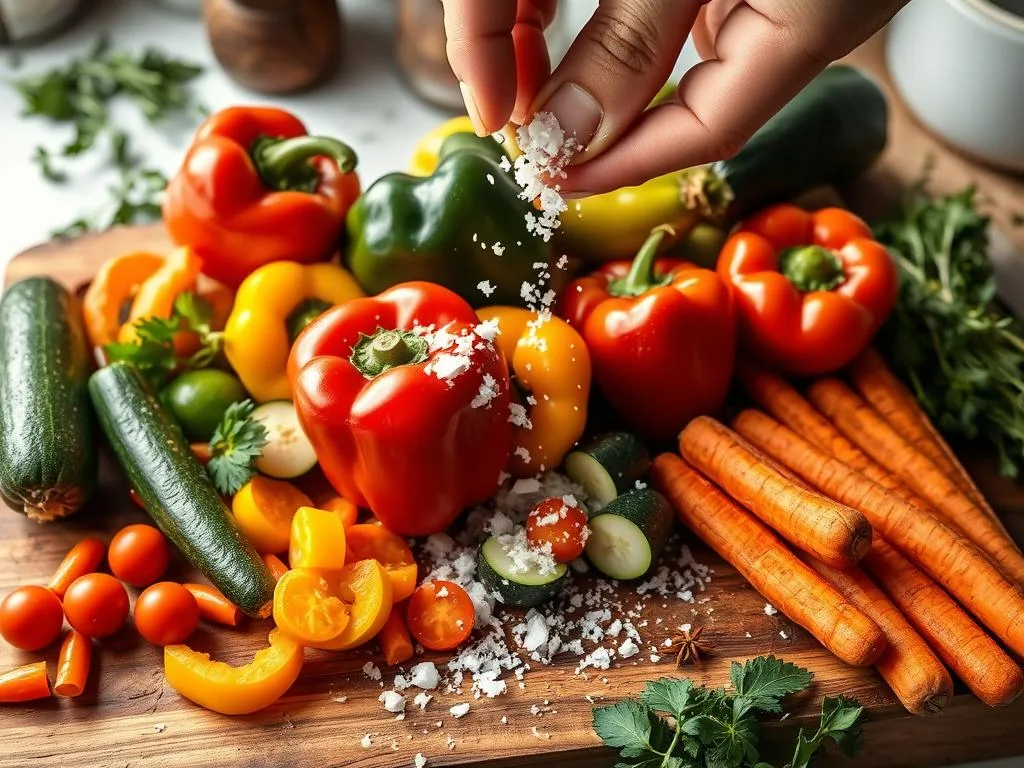Every kitchen adventure starts with a simple secret: mastering how to salt vegetables. I remember my grandmother’s hands hovering over a cutting board. She carefully sprinkled salt that transformed ordinary produce into extraordinary dishes. Those moments taught me that salting vegetables isn’t just about seasoning—it’s an art form that elevates every meal.
Salting techniques for veggies can dramatically change your cooking experience. Imagine crisp, flavorful vegetables that burst with taste in every bite. This guide will walk you through the precise methods to transform your vegetable preparation, turning simple ingredients into culinary masterpieces.
Whether you’re a home cook or aspiring chef, understanding how to salt vegetables is your gateway to creating restaurant-quality dishes right in your own kitchen. We’ll explore proven techniques that will boost your confidence and skill in the culinary world.
Key Takeaways
- Salt is a powerful flavor enhancer for vegetables
- Different vegetables require unique salting approaches
- Proper salting can improve texture and moisture retention
- Timing of salt application significantly impacts flavor
- Balance is crucial to avoid over-salting
Understanding Salt’s Role in Vegetable Preparation
Salt is a game-changer in vegetable seasoning methods. It’s not just about adding flavor—salt transforms the way vegetables taste, look, and feel on your plate. Understanding the science behind salt can elevate your cooking from basic to brilliant.
Salt Types for Vegetable Seasoning
Different salts bring unique characteristics to your vegetable dishes. Here are the top salt varieties for cooking:
- Kosher Salt: Ideal for general vegetable seasoning
- Sea Salt: Provides mineral-rich flavor profiles
- Himalayan Pink Salt: Offers trace minerals and subtle taste
- Flaky Finishing Salt: Perfect for adding texture
How Salt Affects Vegetable Texture
Salt amounts for vegetable dishes can dramatically change their texture. When you salt vegetables, you trigger osmosis—water moves out of plant cells, concentrating flavors and changing consistency.
“Salt is the difference between eating and dining.” – Anonymous Chef
The Science Behind Salt and Vegetables
At a 2% salt concentration, most vegetables ferment beautifully. This precise measurement helps preserve nutrients while enhancing taste. For example:
- Garlic and beetroot thrive with 2% salt
- Cucumbers prefer 3-4% salt concentration
- Delicate vegetables need lighter salting
Mastering salt amounts for vegetable dishes transforms your cooking from ordinary to extraordinary. Experiment with different salts and concentrations to discover your perfect flavor profile.
How to Salt Vegetables: Essential Methods
Learning to salt vegetables is an art that makes simple produce into amazing dishes. It’s key for both raw and cooked veggies. Knowing how to salt can boost your cooking and keep food fresh.
Salting raw veggies uses several methods to boost flavor and keep them fresh. Here are the top ways:
- Direct seasoning
- Salt-water soaking
- Dry brining
- Wild fermentation
For direct seasoning, sprinkle kosher or sea salt lightly on raw veggies. This is best for crisp veggies like cucumbers, tomatoes, and leafy greens. The salt pulls out moisture, making flavors stronger.
“Salt is the magic ingredient that transforms simple vegetables into culinary masterpieces.” – Culinary Expert
Salt-water soaking is another great way to salt raw veggies. Mix 1 tablespoon of salt with a gallon of water. Soak veggies for 5-10 minutes to clean and prepare them.
| Vegetable Type | Salt Method | Recommended Time |
|---|---|---|
| Leafy Greens | Saltwater Soak | 5-10 minutes |
| Root Vegetables | Light Salting | 2-3 minutes |
| Cruciferous Vegetables | Dry Brining | 15-20 minutes |
Dry brining means applying salt directly to veggies without water. It’s great for veggies like zucchini, eggplant, and tomatoes. The salt removes excess moisture, making flavors stronger and textures better.
When salting raw veggies, be precise. Start with a little salt and adjust to taste. Consider the type of veggie you’re using.
The Perfect Salt-to-Vegetable Ratio Guide
Learning how to use salt in veggie recipes is an art. It can make your cooking go from bland to amazing. Knowing the right amount of salt for each vegetable ensures your meals are always seasoned just right.
The amount of salt you use depends on the vegetable and how you cook it. Different veggies need different seasoning levels to bring out their best flavors and textures.
Leafy Greens Salting Measurements
Leafy greens like spinach and kale need a light hand when salting. Here’s a quick guide:
- Spinach: 1/4 teaspoon per cup
- Kale: 1/2 teaspoon per cup
- Swiss chard: 1/3 teaspoon per cup
Root Vegetables Salt Proportions
Root veggies like carrots and potatoes need more salt because they’re denser:
| Vegetable | Salt Ratio | Recommended Amount |
|---|---|---|
| Carrots | 2.2% | 1 1/2 teaspoons per quart |
| Potatoes | 2.5% | 2 teaspoons per quart |
| Beets | 2.2% | 21 grams per quart |
Cruciferous Vegetables Salt Guidelines
Broccoli, cauliflower, and cabbage need specific salt levels for the best fermentation:
- Broccoli: 1.5% – 3% brine concentration
- Cauliflower: 15-30 grams of salt per liter of water
- Cabbage: Typically 2.2% salt ratio for sauerkraut
“The right amount of salt can elevate your vegetables from ordinary to extraordinary.” – Culinary Expert
Pro tip: Always adjust salt levels based on personal taste and specific cooking methods.
Brining Techniques for Maximum Flavor
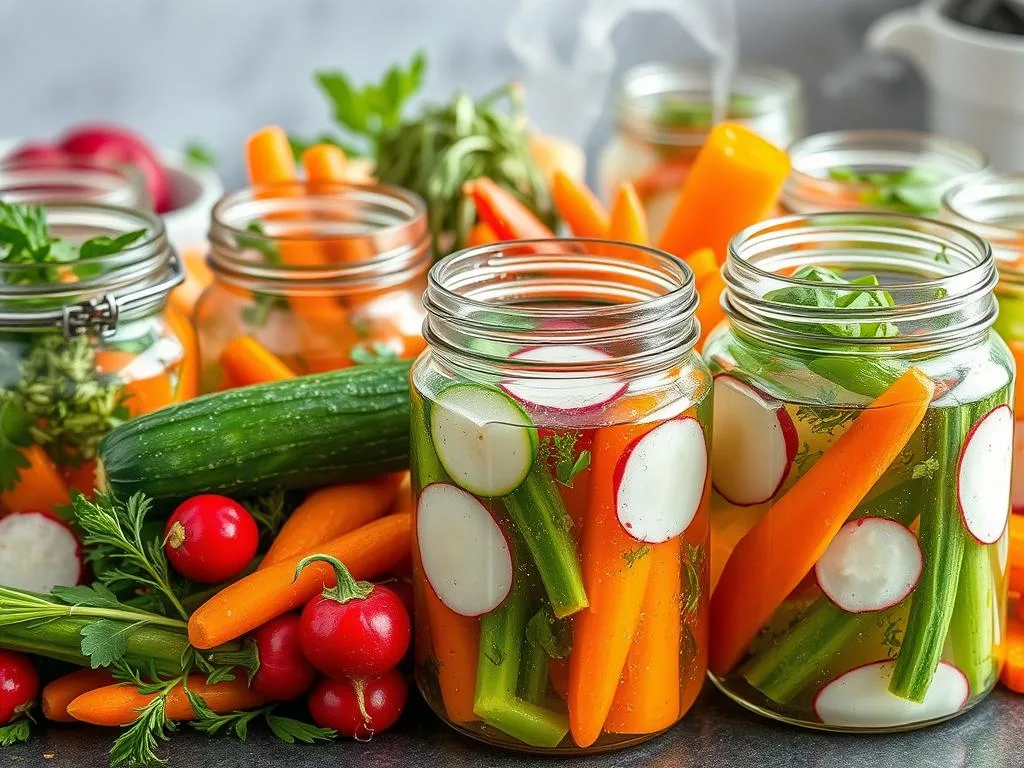
Learning how to brine produce can make your vegetable dishes amazing. Brining is a way to add deep flavor and improve texture to veggies.
Brining works by letting vegetables soak up moisture and flavor from salt. Each veggie reacts differently, opening up new flavors in cooking.
“Salt should be added earlier in the cooking process to achieve a more integrated flavor profile.” – Culinary Expert
Key Brining Methods
- Wet Brining: Submerging vegetables in saltwater solution
- Dry Brining: Directly applying salt to vegetable surface
- Quick Brining: Short-term salt exposure for rapid flavor enhancement
Optimal Brining Recommendations
| Vegetable | Brine Concentration | Recommended Duration |
|---|---|---|
| Green Beans | 5-8% | 30-4 hours |
| Potatoes | 5-8% | 30-4 hours |
| Cauliflower | 5% | Up to 1 hour |
Pro tip: Avoid brining vegetables for more than 12 hours, as this can lead to overly salty or wilted produce.
Brining Best Practices
- Use cold water for brining
- Ensure vegetables are fully submerged
- Maintain proper salt-to-water ratio
- Rinse vegetables after brining to remove excess salt
Try brining different veggies like carrots, asparagus, and zucchini. Find your favorite ways to brine. Remember, the more you practice, the better you’ll get!
Pre-Salting vs. Post-Cooking Seasoning
Seasoning fresh produce right is all about when you add salt. The timing can change how your veggies taste and feel.
Seasoning veggies with salt is more than just adding salt. It depends on six key things:
- Ingredient type
- Preparation method
- Desired cooking outcome
- Salt quantity
- Timing of salt addition
- Salt variety
Benefits of Pre-Salting
Pre-salting has special perks for veggies. Leafy greens get crisper, and some veggies get better texture. For example, pre-salting broccoli before steaming makes it stronger.
“Salt is the silent chef that transforms ingredients from ordinary to extraordinary.”
When to Salt After Cooking
Not every veggie is good for pre-salting. Some might get too wet or tough. For these, seasoning after cooking is better. It lets you control flavor and keeps texture right.
Choose your salt approach based on each veggie’s needs. Some need gentle care, while others can handle more.
- Robust vegetables: Pre-salt generously
- Delicate vegetables: Salt after cooking
- Mixed dishes: Layer salt at different stages
Getting good at salting helps veggies keep their natural taste. It also makes them taste and feel their best.
Common Mistakes in Vegetable Salting
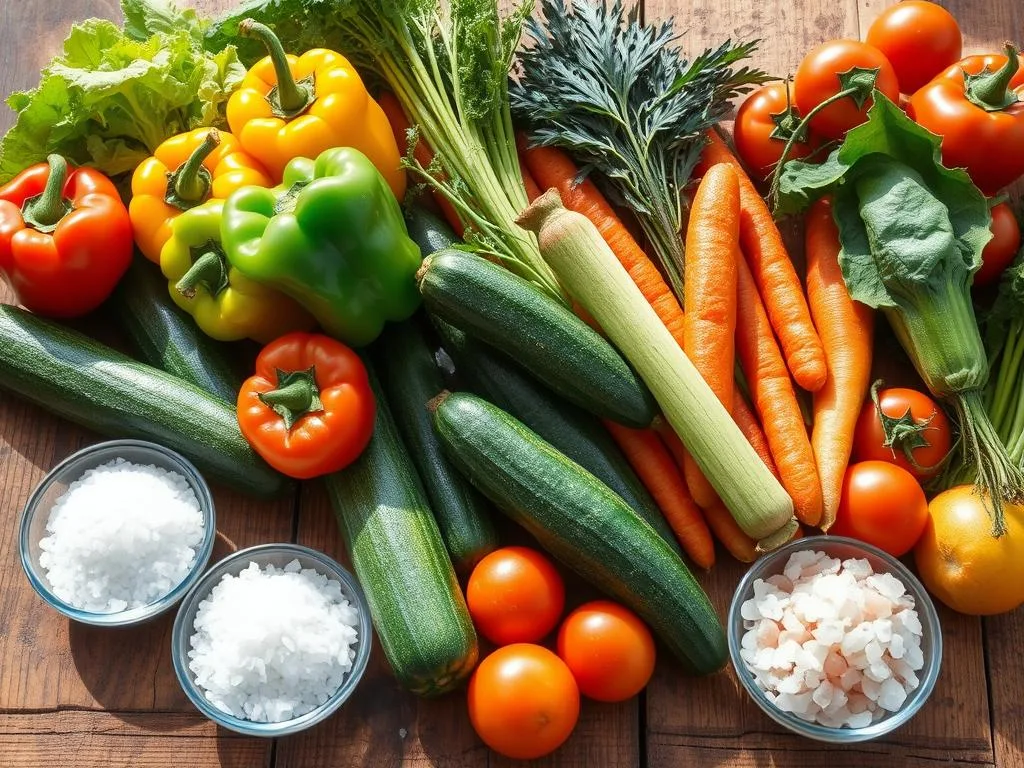
Learning to salt vegetables right isn’t easy. Even skilled cooks can make mistakes. It takes practice and knowledge to get it right.
Here are the top mistakes to watch out for:
- Over-Salting: Too much salt can ruin the vegetable’s taste
- Uneven Salt Distribution: Not spreading salt evenly leads to bad seasoning
- Incorrect Timing: Salting at the wrong time can mess up texture and taste
Getting the salt right is key. About 60% of home cooks struggle with this. The right amount of salt is usually 1.5% to 2.5% of the vegetable’s weight.
“Salt is the difference between a bland dish and a memorable meal.” – Professional Chef
Each vegetable needs a special way of salting. Soft veggies like tomatoes need 30 minutes. Crunchier ones, like cabbage, might need an hour.
- Leafy greens: Gentle salt massage
- Root vegetables: Moderate salting
- Cruciferous vegetables: Longer salting times
Avoiding these mistakes can make your veggies taste amazing. Knowing how to salt them right makes every dish a hit.
Season Like a Pro: Restaurant Techniques
Professional chefs see vegetable seasoning as an art. It turns simple dishes into amazing meals. They know how to use salt to bring out the best in veggies.
Salt is key to adding depth and flavor. Chefs say to season food at every stage of cooking. This builds a rich taste.
Layering Salt Flavors
Flavor layering is all about when and how to use salt:
- Start with a pinch of salt during initial cooking
- Taste and adjust seasoning progressively
- Use kosher salt for better flavor distribution
- Add salt in small increments to control intensity
“Salt is the difference between a good dish and an extraordinary one.” – Professional Chef Wisdom
Timing Your Salt Application
Knowing when to add salt is key. Different veggies need different approaches:
- Root vegetables: Salt before roasting
- Leafy greens: Salt just before serving
- Cruciferous vegetables: Salt midway through cooking
Pro tip: Always taste your dish after salting. This ensures the flavor is balanced. The aim is to enhance, not overpower, the natural taste of the veggies.
Salt-Free Alternatives and Substitutes
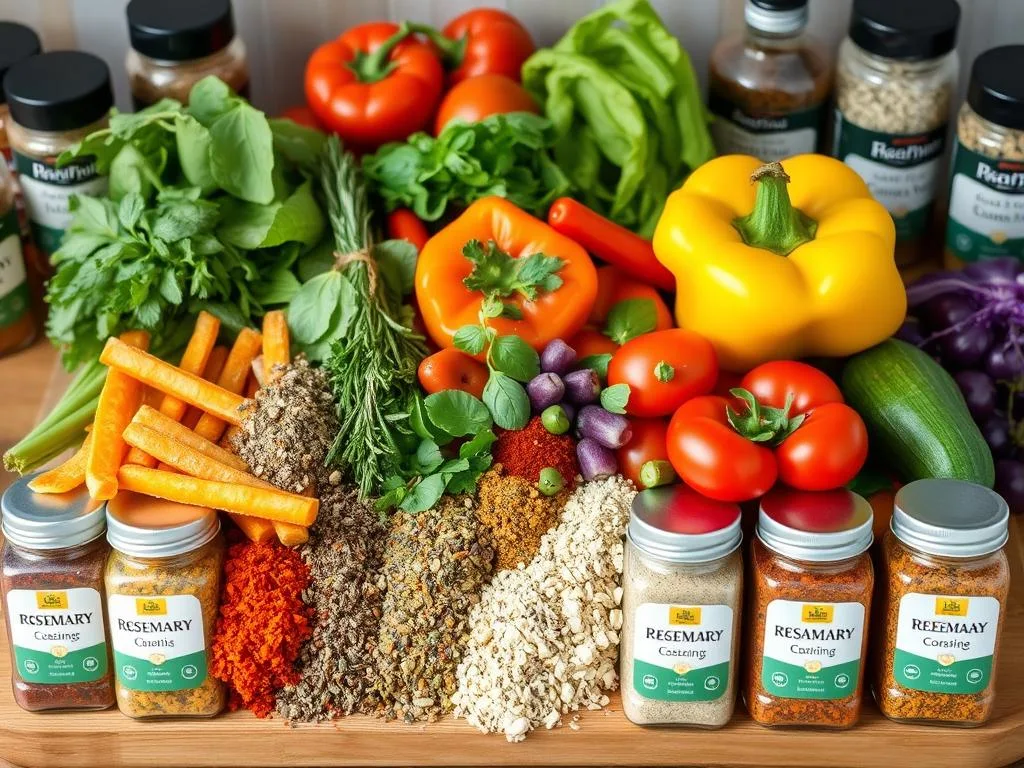
Reducing salt in veggie recipes doesn’t mean losing flavor. If salt is a health concern, many tasty alternatives can change your cooking.
Looking into salt-free options can spark creativity in the kitchen. Fresh herbs and spices add great taste without sodium.
- Fresh Herbs: Basil, thyme, rosemary, and oregano bring strong flavors
- Spice Blends: Cumin, paprika, and garlic powder offer deep tastes
- Citrus Zests: Lemon and orange rinds make dishes bright
- Vinegars: Balsamic and apple cider vinegars add depth without sodium
Potassium chloride-based salt substitutes are great for those watching sodium. Nearly 50% of adults face high blood pressure, making these options very important.
“Flavor doesn’t have to come from salt – nature provides countless delicious alternatives.” – Culinary Nutrition Expert
Here are some tips for low-sodium veggie prep:
- Roast vegetables to bring out their natural sweetness
- Try new herb mixes
- Use sodium-free seasoning blends
- Add aromatic ingredients like ginger and garlic
The American Heart Association suggests a daily sodium limit of 2,300 milligrams. Using these salt-free options can lead to healthier, tasty meals.
Specialty Salts for Different Vegetables
Take your vegetable dishes to the next level with specialty salts. Not all salt is the same. The right salt can make a big difference in flavor.
- Fleur de Sel: A delicate sea salt perfect for delicate vegetables like asparagus and baby greens
- Smoked Salt: Ideal for robust vegetables like grilled zucchini or roasted Brussels sprouts
- Black Lava Salt: Adds dramatic visual and flavor impact to root vegetables
- Himalayan Pink Salt: Provides mineral-rich seasoning for hearty vegetable dishes
“Specialty salts are not just about saltiness, but about creating layers of flavor in your dishes.” – Culinary Expert
Specialty salts can change how you season vegetables. Each salt has its own minerals and texture. These interact differently with various vegetables.
| Salt Type | Best Vegetable Pairings | Flavor Profile |
|---|---|---|
| Fleur de Sel | Leafy Greens, Delicate Vegetables | Subtle, Mineral-Rich |
| Smoked Salt | Grilled Vegetables, Root Vegetables | Intense, Smoky |
| Himalayan Pink Salt | Roasted Vegetables, Hearty Dishes | Rich, Mineral-Forward |
Pro tip: Start with small amounts of specialty salts. See which ones work best with your favorite vegetables. Remember, a little goes a long way in adding flavor.
Health Considerations When Salting Vegetables
It’s important to find the right balance between taste and nutrition when seasoning veggies. Salt is key in cooking veggies, but we must watch our sodium intake for health.
Sodium Content Awareness
Americans eat about five teaspoons of salt each day. This is way more than our bodies need. We only need about 1/4 teaspoon of salt daily. So, it’s key to keep an eye on salt in our veggie recipes.
- Daily sodium intake target: Less than 2,000 milligrams
- Low-sodium foods: Contains less than 140 mg per serving
- High-sodium foods: Contains 400 mg or more per serving
Balancing Flavor and Health
It’s possible to make tasty veggie dishes without harming your health. With smart seasoning, you can boost flavor while controlling sodium.
| Food Category | Sodium Considerations | Recommended Alternatives |
|---|---|---|
| Canned Vegetables | High Sodium | Fresh or Frozen Vegetables |
| Processed Foods | Excessive Sodium | Home-Cooked Meals |
| Pickled Items | Very High Sodium | Fresh Vegetables |
“Salt is a powerful ingredient, but moderation is key to maintaining both flavor and health.” – Culinary Nutrition Expert
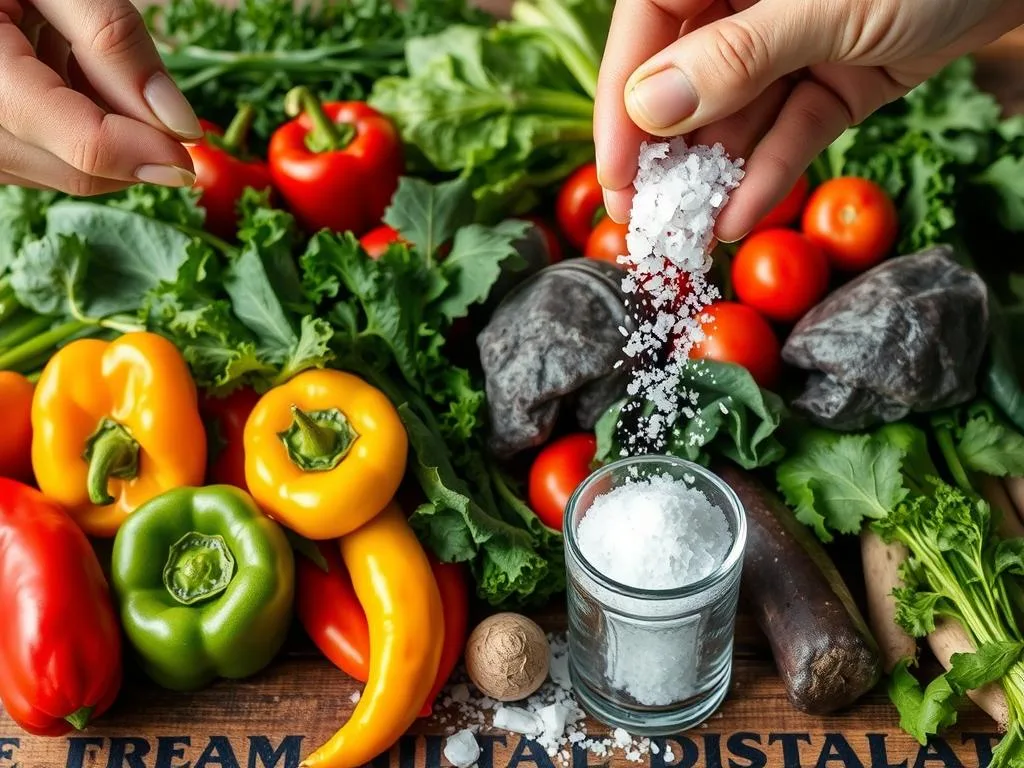
Knowing how salt works in cooking veggies and making smart choices can lead to healthy, tasty meals. This supports your overall well-being.
Storage Tips for Salted Vegetables
Keeping your salted vegetables fresh is key. After you’ve salted them, how you store them matters a lot. It helps keep the taste and makes them last longer.
Here are some important storage tips:
- Use airtight containers to prevent moisture and bacteria
- Store brined produce in cool, dark locations
- Refrigerate vegetables after the brining process for produce
- Check stored vegetables weekly for any signs of spoilage
“The secret to great vegetable preservation is understanding the delicate balance of salt and storage conditions.” – Culinary Preservation Expert
Each vegetable needs its own storage method. Root veggies do well with a light sprinkle of salt to stop rot. Leafy greens can be kept fresh by soaking them in saltwater for a few minutes before chilling.
Temperature is also very important. Most salted veggies stay good between 32-40°F (0-4°C). Dried veggies preserved with salt can last months in sealed containers.
Practical Storage Recommendations
- Use glass or ceramic containers for brined vegetables
- Label containers with the date of salting
- Maintain consistent refrigeration
- Consume within recommended time frames
Pro tip: Always trust your senses. If a salted vegetable looks, smells, or tastes off, it’s best to discard it.
Seasonal Adjustments for Salt Levels
Knowing how seasons change vegetable flavors is key to perfecting your salting. Each season brings its own challenges and chances for seasoning your favorite veggies.
Your salting method should change with the seasons. Salt amounts for veggies can vary with the season’s characteristics.
- Summer Vegetables: Typically more water-rich and sweeter
Recommendation: Use less salt, as natural flavors are more pronounced - Winter Vegetables: Often denser and less moisture-intensive
Recommendation: Slightly increase salt to enhance depth of flavor - Spring Produce: Tender and delicate
Recommendation: Minimal salting to preserve subtle tastes - Autumn Vegetables: Robust and earthy
Recommendation: Moderate salt levels to complement rich flavors
Professional chefs suggest adjusting your salting tips for veggies with the seasons. A good rule is to use about 1/2 teaspoon of salt per pound of veggies. But, adjust this based on the season.
“Seasonality transforms vegetables from simple ingredients to culinary experiences.” – Chef Marcus Rodriguez
Try different salt levels and taste as you go. Your taste buds are the best guide to mastering seasoning veggies by season.
Conclusion
Learning to salt vegetables is more than a cooking trick. It’s a journey that turns simple produce into amazing dishes. You’ve learned how to make flavors pop, keep food fresh, and cut down on waste.
Salt is not just for flavor; it’s a food saver. It keeps leafy greens fresh and stops bacteria in root veggies. With the right salt techniques, you can store veggies for up to 6 months, keeping them tasty and nutritious.
Keep trying out different salting methods. Each veggie needs its own special touch. Whether it’s cucumbers or cabbage, be curious and confident. Your skills will make your cooking better, reduce waste, and create lasting, tasty veggie dishes.
Looking for more delicious recipes to try? Explore these amazing dishes on American Tasty:
- Red Lentil Soup with Warm Spices: A comforting, flavorful soup perfect for any season.
- Fishcakes and Scallops Stir-Fry Recipe: A quick and easy seafood dish with a savory twist.
- Chocolate Espresso Dacquoise: A decadent dessert that combines chocolate and coffee flavors.
- Crab Dip: A creamy, crowd-pleasing appetizer for any gathering.
- Pea Salad: A fresh, vibrant side dish that’s perfect for summer meals.
- Breakfast Lasagna: Start your day with a hearty and unique breakfast recipe.
- Pumpkin Soup: A rich, velvety soup that’s ideal for autumn evenings.
Join Our Community!
💬 Facebook: Stay updated with our latest recipes, cooking tips, and delicious inspiration. Join the conversation and share your creations with us on American Tasty’s Facebook page.
📌 Pinterest: Discover mouthwatering recipe ideas and save them for later! Follow our boards on American Tasty’s Pinterest for endless culinary inspiration.
✨ Why Join?
- Get exclusive recipes and updates.
- Share your food creations and inspire others.
- Connect with a community of food lovers like you!
